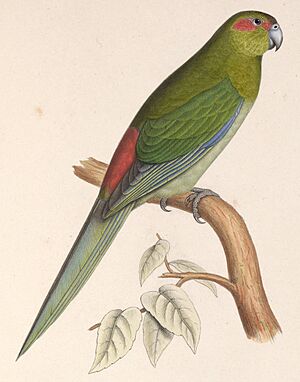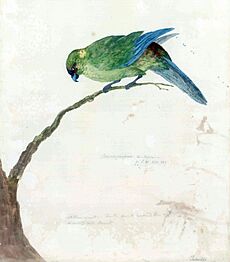Black-fronted parakeet facts for kids
Quick facts for kids Black-fronted parakeet |
|
|---|---|
 |
|
| An illustration from 1849 | |
| Conservation status | |
| Scientific classification | |
| Genus: |
Cyanoramphus
|
| Species: |
zealandicus
|
| Synonyms | |
|
Psittacus zealandicus Latham, 1790 |
|
The black-fronted parakeet was a special type of parrot. It was also known as the Tahiti parakeet. Its scientific name was Cyanoramphus zealandicus. This bird used to live only on the Pacific island of Tahiti. When a plant or animal lives only in one place, it is called endemic.
The people of Tahiti had a name for this parrot. They called it ’ā’ā, which simply means "parrot". Some records also show it was called "aa-maha". Sadly, this beautiful bird is now extinct, meaning it no longer exists anywhere in the world.
Discovering the Parakeet
The black-fronted parakeet was first found during James Cook's first trip around the world in 1769. On this trip, some of these birds were collected. Today, two of these original birds are kept in a museum in Liverpool, England. Another one is in the Walter Rothschild Zoological Museum in Tring.
It's possible that some of these birds were also collected during Cook's second trip in 1773. However, the first drawing of this parakeet was made by Sydney Parkinson. He was an artist who died in 1771. This means the very first bird studied was from the first voyage.
Later, in 1842, another parakeet was collected by someone named Amadis. This bird is now in a museum in Perpignan, France. The very last known black-fronted parakeet was collected in 1844. It was found by Lieutenant des Marolles. This final bird is now kept in the Muséum national d'Histoire naturelle in Paris, France.
Why Did It Disappear?

The black-fronted parakeet lived in the forests of Tahiti. Like its relative, the Society parakeet, it was quite tough. Even when people started cutting down many trees for farming, the parakeets were still around. There were also small kiore rats and pigs on the island. These animals sometimes ate the birds' eggs. But the parakeets still managed to survive in good numbers.
The native people of Tahiti loved red parrot feathers. They used them to make beautiful crafts. However, the black-fronted parakeet did not have enough of the bright red feathers they wanted. So, they often traded with people from Samoa to get these special feathers. The Tahitians also liked to keep the black-fronted parakeets as pets.
The biggest problem for these parakeets came when new animals arrived on the island. European sailors brought cats and new types of rats to Tahiti. These new animals were very good hunters. They quickly became a huge threat to the parakeets. Because of these new predators, the black-fronted parakeet rapidly disappeared. It became extinct around 1850.


